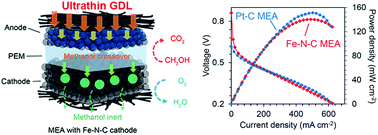当前位置:
X-MOL 学术
›
J. Mater. Chem. A
›
论文详情
Our official English website, www.x-mol.net, welcomes your
feedback! (Note: you will need to create a separate account there.)
Anodic engineering towards high-performance direct methanol fuel cells with non-precious-metal cathode catalysts†
Journal of Materials Chemistry A ( IF 10.7 ) Pub Date : 2019-12-28 , DOI: 10.1039/c9ta11440h Zhangxun Xia 1, 2, 3, 4, 5 , Xinlong Xu 1, 2, 3, 4, 5 , Xiaoming Zhang 1, 2, 3, 4, 5 , Huanqiao Li 1, 2, 3, 4, 5 , Suli Wang 1, 2, 3, 4, 5 , Gongquan Sun 1, 2, 3, 4, 5
Journal of Materials Chemistry A ( IF 10.7 ) Pub Date : 2019-12-28 , DOI: 10.1039/c9ta11440h Zhangxun Xia 1, 2, 3, 4, 5 , Xinlong Xu 1, 2, 3, 4, 5 , Xiaoming Zhang 1, 2, 3, 4, 5 , Huanqiao Li 1, 2, 3, 4, 5 , Suli Wang 1, 2, 3, 4, 5 , Gongquan Sun 1, 2, 3, 4, 5
Affiliation

|
Direct methanol fuel cells (DMFCs) have drawn extensive interest for the past two decades both in scientific research and industrial engineering circles for their advantages of high energy density, environmental friendliness, and easy fuel handling. However, their excessively high costs, especially derived from the massive use of precious metal catalysts in both their anodes and cathodes, hamper the commercialization of this technology to the general public. Though the production of inexpensive catalysts of methanol oxidation remains challenging, non-precious-metal-based catalysts of the oxygen reduction reaction have seen considerable technical progress, yielding remarkable performance levels in hydrogen-fueled polymer electrolyte membrane fuel cells (PEMFCs). Due to the particularities of the electrochemical reactions and mass transport for methanol fuel in DMFC electrodes, highly active non-precious metal catalysts have not yielded sufficiently satisfactory single-cell performances for practical applications. In the current work, rather than exploring the cathodic designs with advanced electrode materials and structures, we estimated the mass transport of methanol and its effects on cathode performance, and then redesigned the anode architecture with ultrathin gas diffusion layers based on carbon nanotube composite materials. By using such an alternative strategy focused on anodic engineering to accelerate methanol transport combined with the use of a methanol-inert cathode, an ultrahigh cell performance, comparable to those of Pt–C-containing cathodes, was achieved even at a low methanol concentration. The peak power density obtained was 141 mW cm−2, a value among the highest obtained from DMFCs with non-precious-metal catalyst cathodes to the best of our knowledge. A wider avenue of DMFC technologies for practical applications might be opened with further development of this work.
中文翻译:

使用非贵金属阴极催化剂进行高性能直接甲醇燃料电池的阳极工程†
在过去的二十年中,直接甲醇燃料电池(DMFC)具有高能量密度,环境友好和易于燃料处理的优点,在科学研究和工业工程界引起了广泛的兴趣。然而,它们的过高成本,特别是由于在阳极和阴极中大量使用贵金属催化剂而产生的成本,阻碍了该技术对公众的商业化。尽管廉价的甲醇氧化催化剂的生产仍然具有挑战性,但是氧还原反应的非贵金属基催化剂已经取得了可观的技术进步,在氢燃料电池聚合物电解质膜燃料电池(PEMFC)中产生了显着的性能水平。由于DMFC电极中甲醇燃料的电化学反应和传质的特殊性,高活性的非贵金属催化剂不能为实际应用提供足够令人满意的单电池性能。在当前的工作中,我们没有研究先进的电极材料和结构的阴极设计,而是估算了甲醇的质量传递及其对阴极性能的影响,然后重新设计了基于碳纳米管复合材料的超薄气体扩散层的阳极结构。通过采用这种专注于阳极工程的替代策略来加速甲醇的运输,并结合使用甲醇惰性阴极,可实现超高的电池性能,可与含Pt-C的阴极相媲美,即使在低甲醇浓度下也能达到目标。获得的峰值功率密度为141 mW cm−2,就我们所知,该值是使用非贵金属催化剂阴极的DMFC获得的最高值。随着这项工作的进一步发展,可能会为实际应用提供更广泛的DMFC技术途径。
更新日期:2020-01-08
中文翻译:

使用非贵金属阴极催化剂进行高性能直接甲醇燃料电池的阳极工程†
在过去的二十年中,直接甲醇燃料电池(DMFC)具有高能量密度,环境友好和易于燃料处理的优点,在科学研究和工业工程界引起了广泛的兴趣。然而,它们的过高成本,特别是由于在阳极和阴极中大量使用贵金属催化剂而产生的成本,阻碍了该技术对公众的商业化。尽管廉价的甲醇氧化催化剂的生产仍然具有挑战性,但是氧还原反应的非贵金属基催化剂已经取得了可观的技术进步,在氢燃料电池聚合物电解质膜燃料电池(PEMFC)中产生了显着的性能水平。由于DMFC电极中甲醇燃料的电化学反应和传质的特殊性,高活性的非贵金属催化剂不能为实际应用提供足够令人满意的单电池性能。在当前的工作中,我们没有研究先进的电极材料和结构的阴极设计,而是估算了甲醇的质量传递及其对阴极性能的影响,然后重新设计了基于碳纳米管复合材料的超薄气体扩散层的阳极结构。通过采用这种专注于阳极工程的替代策略来加速甲醇的运输,并结合使用甲醇惰性阴极,可实现超高的电池性能,可与含Pt-C的阴极相媲美,即使在低甲醇浓度下也能达到目标。获得的峰值功率密度为141 mW cm−2,就我们所知,该值是使用非贵金属催化剂阴极的DMFC获得的最高值。随着这项工作的进一步发展,可能会为实际应用提供更广泛的DMFC技术途径。











































 京公网安备 11010802027423号
京公网安备 11010802027423号